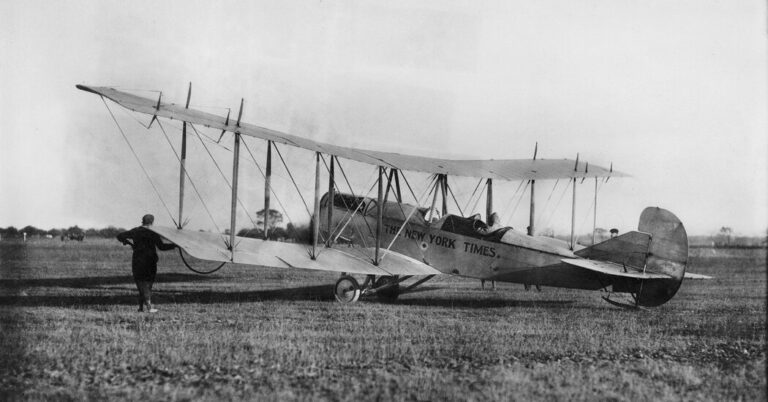In the In Times Past column, David W. Dunlap explores New York Times history through artifacts housed in the Museum of The Times, for which he is curator.
In charting the flight of the battery-powered CX300 aircraft recently, The New York Times was back where it has spent a lot of time over the last 120 years: in the clouds.
Admittedly, The Times missed the first flights by the Wright brothers near Kitty Hawk, N.C., on Dec. 17, 1903. But nine days later, the newspaper ran a short article on Page 1 about the Wrights’ desire to sell their “North Carolina Box Kite Machine” to the government, possibly for use in “torpedo warfare.”
Under the dynamic managing editor Carr V. Van Anda (1864-1945), The Times embraced the pioneering field of aviation. In May 1910, Van Anda hired a special express train to follow under Glenn H. Curtiss as he made one of the earliest cross-country flights, from Albany to New York City. A month later, The Times and The Philadelphia Public Ledger (both owned by Adolph S. Ochs) awarded $10,000 to Charles K. Hamilton for flying round-trip between those two cities in a single day.
The Times took the brazen step in 1916 of slapping its name on a 200-horsepower Curtiss biplane, piloted by Victor Carlstrom, that was supposed to make a sunrise-to-sunset voyage from Chicago to New York, carrying more than 1,000 letters and postcards for the United States Post Office, in an early demonstration of airmail. A photo of “The New York Times” aircraft is in the Museum at The Times.
Carlstrom’s dream of a one-day trip sputtered to an end around Erie, Pa. After putting down, he found that a nut was missing in the gasoline line. He fixed that and made it to Hammondsport, N.Y., where he spent the night.
“The New York Times” finally arrived on Governors Island the next day, Nov. 3, 1916, having spent a total of 8 hours, 28 minutes and 30 seconds in the air.
“Carlstrom has demonstrated that the passage between the two greatest cities of America can undoubtedly be made through the air without a stop,” The Times said in an editorial. The aviator shared the newspaper’s optimism. “Some day I’m going to leave Chicago at 6 o’clock and have lunch in New York at noon,” Carlstrom told The Times after completing his 967-mile trip.
Instead, he was killed just six months later. In a plane crash.


